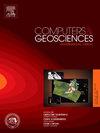A combined deep learning and morphology approach for DFS identification and parameter extraction
IF 4.4
2区 地球科学
Q1 COMPUTER SCIENCE, INTERDISCIPLINARY APPLICATIONS
引用次数: 0
Abstract
Since the concept of the Distributive Fluvial System (DFS) was introduced, understanding DFS river parameters has been vital for oil and gas reservoirs. Traditional measurement methods are often time-consuming and labour-intensive. This paper presents a deep learning and morphology-based method for the automatic extraction of DFS river parameters. We propose an optimized model, Seg_ASPP, which integrates Segformer and ASPP (Atrous Spatial Pyramid Pooling) to generate river network masks. The river centerline is then extracted via accumulation cost and polynomial fitting algorithms, allowing for length, width, and sinuosity calculations. Using the Geermu DFS area in the Qaidam Basin for evaluation, we compare the parameters extracted via our method against manual measurements. The average relative errors for length, width, and curvature are 10.22%, 13.57%, and 5.41%, respectively, demonstrating the strong performance of the model. Our experiments show that the DFS parameter extraction method proposed in this paper has great potential for practical applications.

一种结合深度学习和形态学的DFS识别和参数提取方法
自分拨河流系统(DFS)的概念被引入以来,了解分拨河流系统的河流参数对油气藏的研究具有重要意义。传统的测量方法往往耗时耗力。提出了一种基于深度学习和形态学的DFS河流参数自动提取方法。我们提出了一种优化模型Seg_ASPP,该模型集成了Segformer和ASPP (Atrous Spatial Pyramid Pooling)来生成河网掩模。然后通过累积成本和多项式拟合算法提取河流中心线,允许计算长度,宽度和弯曲度。以柴达木盆地格尔木DFS区为例,将该方法提取的参数与人工测量结果进行了比较。长度、宽度和曲率的平均相对误差分别为10.22%、13.57%和5.41%,表明该模型具有较强的性能。实验表明,本文提出的DFS参数提取方法具有很大的实际应用潜力。
本文章由计算机程序翻译,如有差异,请以英文原文为准。
求助全文
约1分钟内获得全文
求助全文
来源期刊

Computers & Geosciences
地学-地球科学综合
CiteScore
9.30
自引率
6.80%
发文量
164
审稿时长
3.4 months
期刊介绍:
Computers & Geosciences publishes high impact, original research at the interface between Computer Sciences and Geosciences. Publications should apply modern computer science paradigms, whether computational or informatics-based, to address problems in the geosciences.
 求助内容:
求助内容: 应助结果提醒方式:
应助结果提醒方式:


